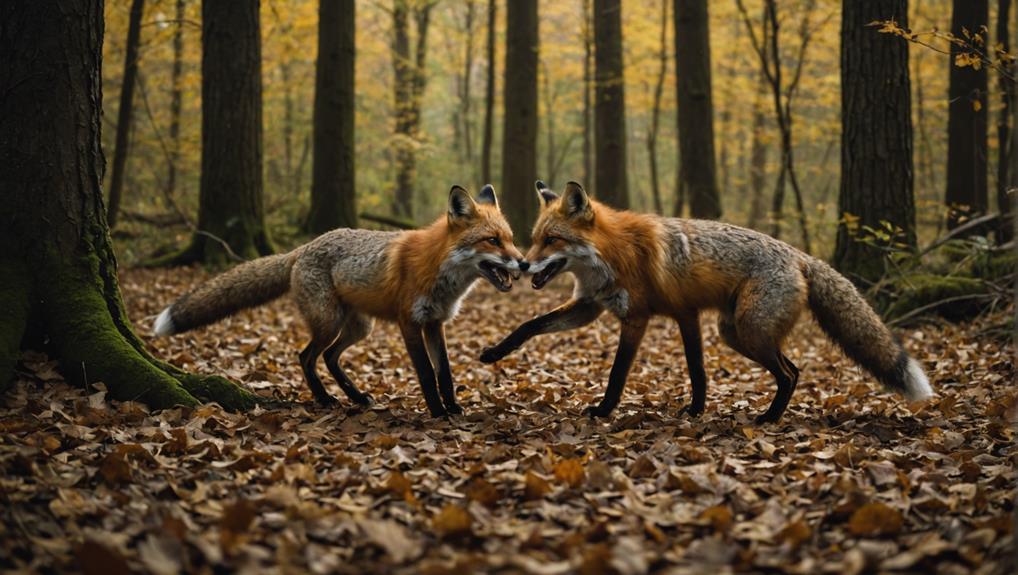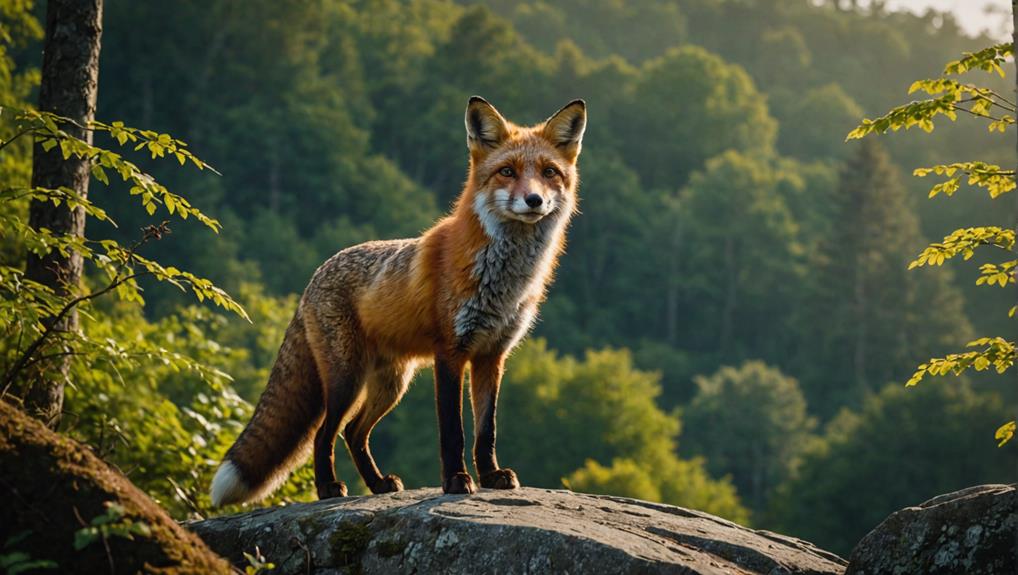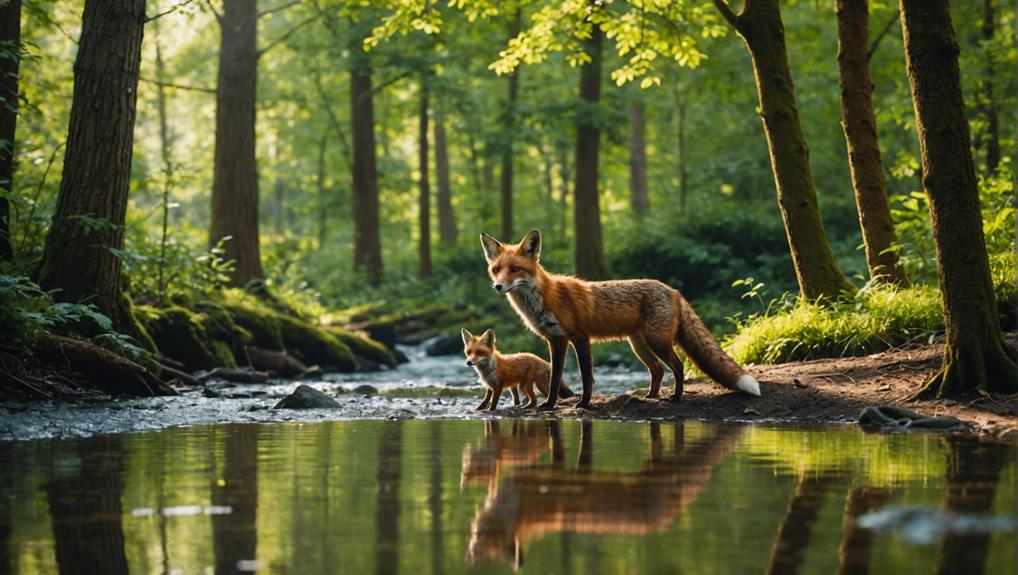Foxes in the wild are a lively bunch, thriving on family ties, playful interactions, and clever communication skills. They live in tight-knit family units, where dominant pairs manage resources and territory, ensuring everyone's got a place to call home. You'll spot these clever critters communicating through barks, growls, and even some hilarious "gekking" noises. Playtime is crucial too! Young foxes engage in mock fights to sharpen their social skills, while grooming helps strengthen their bonds. With all this teamwork, they're better equipped to face the challenges of nature. Stick around, and you might uncover even more about their whiskered world!
Contents
Canid Social Structure
In understanding canid social structure, you'll find that foxes display a more fluid organization than many might expect. They often form nuclear family units, which consist of a breeding pair and their pups.
Unlike what you might read in books about alpha and beta roles, these social hierarchies shift based on group dynamics. It's less about ranking and more about cooperation and adaptability, similar to how urban foxes navigate their environments amidst human interactions and resource availability urban habitats contribute to survival.
You'll notice that access to resources and territory plays a big role in their social structure. Dominant foxes usually manage the prime spots and get first dibs on breeding opportunities.
But don't think it's all about brawn; agonistic behaviors, like displays of aggression or submission, are key to maintaining their social order. It's kind of like a reality show, where everyone has their role to play!
When it comes to territorial defense, foxes use vocalizations and scent marking to keep their boundaries clear. This helps reduce conflicts and fosters group cohesion.
Communication Methods
Foxes utilize a rich tapestry of communication methods to interact with one another. They're not just cute animals; they've got a whole system for talking! You might hear various vocalizations like barks, growls, and even screams. Each sound carries a different meaning, whether it's an alert or a playful call.
Scent marking is another vital communication method. When you see a fox lifting its leg, it's not just being dramatic. Foxes use urine and feces to set up territorial boundaries and share their reproductive status. It's their way of saying, "This is my space!"
Body language is just as important. You can tell a lot about a fox's mood by observing its posture. Dominant foxes strut around with erect tails and upright ears, while submissive ones might lower their heads and flatten their ears.
Lastly, don't forget about the fox cubs! They engage in playful fighting, which teaches them valuable social skills. Here's a quick overview of these communication methods:
| Method | Description | Purpose |
|---|---|---|
| Vocalizations | Barks, growls, screams | Convey emotions/alerts |
| Scent Marking | Urine/feces marking | Establish territory/repro status |
| Body Language | Posture and ear position | Show dominance or submission |
Aggression and Competition

Aggression and competition play significant roles in the social dynamics of foxes, especially among cubs and adults. From a young age, cubs start to navigate their social ranking, which can be fierce! In the wild, these social interactions are vital for survival, as they help establish key adaptations for survival within the group.
Believe it or not, aggression can kick off as early as three weeks old. Here are some key points about aggression and competition in foxes:
- Size and strength influence cubs' social ranking and competitive behaviors.
- About 20% of cubs mightn't survive due to aggressive interactions over limited food.
- Males display aggression during mating seasons, shoving and biting to show dominance.
- Vixens often engage in intrasexual aggression, fiercely protecting their territories.
Territorial disputes can get intense, especially when it comes to breeding.
Dominant foxes usually manage the best territories and opportunities, while the less dominant ones act submissively to keep the peace. It's a crafty dance of hierarchy and survival!
So, while it might sound rough, this aggression is essential for survival, ensuring that the strongest genes carry on.
Next time you hear a fox's call, remember there's more to it than just a cute sound—there's a whole world of competition behind it!
Play and Social Behavior
When you think about young foxes, it's hard not to smile at their playful antics! They engage in mock fights and chase games, which aren't just fun but also help them learn important social skills and build their family ties.
In species like the Fennec Fox that live in the Sahara Desert, these playful interactions are essential for maintaining harmony within their family groups.
Plus, their grooming rituals and body language are like a secret language that strengthens their bonds and keeps the peace—after all, who wouldn't want to avoid a tussle over a snack?
Importance of Play Fighting
Play fighting is fundamental for red fox cubs, as it not only helps them establish their social hierarchy but also equips them with essential skills for future interactions. You might think it's just fun and games, but there's more to it than that! Through playful tussles with their siblings, these cubs learn important lessons that will serve them well later on.
Here are a few key benefits of play fighting:
- Establishes social hierarchy: Cubs learn their place in the family group, which is important for harmony.
- Develops important skills: They practice strength, agility, and timing, all essential for hunting and competing.
- Reduces injury risk: The playful nature of these interactions minimizes the chance of serious injuries during real fights.
- Strengthens social bonds: Play fighting fosters connections between siblings and between parents and offspring.
Even adult foxes get in on the action during courtship, proving that play fighting isn't just for the youngsters.
It reinforces social bonds and keeps the community tight-knit. So next time you see a cub rolling around, remember—it's all part of their training for life!
Grooming and Bonding Rituals
Grooming and bonding rituals are essential components of social behavior in foxes, building on the playful interactions seen in cubs. You mightn't realize it, but when foxes groom each other, they're doing more than just keeping clean.
This grooming strengthens social bonds, helping family groups stick together and promoting stability within the pack. Without these rituals, some foxes could end up feeling isolated, which isn't good for their social lives!
Play fighting, often seen in young foxes, isn't just for fun; it also helps establish and reinforce social hierarchy. You'll notice that dominant foxes often show off their status through their body language, like standing tall with erect tails and upright ears.
They know how to communicate dominance without throwing punches, so to speak. These interactions minimize aggressive confrontations, keeping the peace within the group.
It's fascinating how grooming and playful behaviors reveal so much about their relationships and social structures. So, next time you think of a fox, picture them snuggling and playfully tussling, all while carefully maneuvering the complexities of their social world. Isn't nature amazing?
Communication Through Body Language
Foxes communicate a wealth of information through their body language, revealing their social status and emotional states. You mightn't realize it, but every twitch and tilt conveys a message.
For instance, dominant individuals stand tall with erect tails and upright ears, while submissive foxes lower their heads and flatten their ears. It's like a silent language that speaks volumes!
Here are some key elements of their body language:
- Body Postures: Different stances showcase their confidence or submission.
- Grooming Behaviors: Foxes engage in grooming to strengthen social bonds—kind of like an animal version of a group hug!
- Vocalizations: Sounds like "gekking" often accompany body signals, indicating aggression or conflict.
- Foxtrot Behavior: This ritualized display helps establish dominance while avoiding real fights.
Play fighting, especially among cubs, is also essential. It lets them practice hunting skills and build relationships without the stress of actual confrontations.
Territoriality and Resource Management

When you think about foxes, their cleverness in managing territory might surprise you.
Dominant pairs put in a lot of effort to guard their space, sometimes stretching over hundreds of acres, especially when food becomes scarce.
It's interesting how they use scent marking and vocal sounds to keep the peace, even if it means some of them have to take the long way around to avoid a spat!
Territory Defense Strategies
Establishing and defending territory is essential for survival, as it allows foxes to secure important resources and breeding opportunities. In the wild, foxes rely on vocalizations and scent markings to communicate their boundaries. This is significant because a well-defined territory reduces the chances of aggressive encounters with other foxes.
Let's break down how they master this territory defense:
- Vocalizations: Foxes use barks, screams, and howls to warn others off their turf.
- Scent Markings: They strategically leave their scent around the edges of their home range to signal their presence.
- Intrasexual Aggression: Particularly among vixens, this behavior helps secure breeding opportunities and food resources.
- Dominant Pairs: These leaders often manage territory defense, fending off intruders and maintaining order within the group.
Scarcity of food can heighten territorial disputes, leading to a hierarchy that affects social interactions. The size of a fox's home range varies, usually between 57.5 ha and 768 ha, depending on food availability and population density.
Resource Allocation Dynamics
In the intricate world of fox communities, the interplay between territoriality and resource management shapes social dynamics. Dominant breeding pairs take charge of territory management, setting boundaries to secure their resources. You might notice that vixens often engage in intrasexual aggression, defending their turf with fierce determination, sometimes even more than the males do.
When food is scarce, competition heats up, and you can bet there'll be some tense moments.
Social hierarchies among foxes are quite fluid. You'll see shifts in dominance and resource access, especially when new individuals join or leave the group. This constant change keeps things interesting!
To navigate conflicts and establish their pecking order, foxes rely on body language and vocalizations. You might spot a fox arching its back or hear a series of sharp barks, all part of their toolkit for conflict resolution.
In a way, these resource allocation dynamics are like a never-ending game of chess, where each move matters. So, next time you see a fox, remember it's not just hunting for food; it's also managing its little slice of the wild!
Seasonal Interaction Dynamics
How do seasonal changes shape the social dynamics among foxes? Well, the answer is quite fascinating! As the seasons shift, so do the relationships within fox family groups.
During autumn, male cubs hit sexual maturity, and tensions rise. You might notice some drama unfold among them. Here are a few key dynamics to keep in mind:
- Breeding Season: Dominant pairs focus on reproduction, often pushing lower-ranking members to the sidelines.
- Food Scarcity: When food gets scarce, aggressive interactions spike, leading to shifts in hierarchy.
- Family Group Adjustments: As resources change, so do the roles within the family, which can lead to some surprising social reshuffling.
- Winter Strategies: In winter, foxes band together in loose social structures to forage more efficiently, especially when competition for food heats up.
These seasonal changes create a whirlwind of social dynamics that keeps fox families on their toes. It's like a nature reality show, just with more fur and fewer dramatic confessions!
Final Thoughts
So, next time you think about foxes, remember they're not just cute little critters; they're social beings with complex lives. Did you know that a group of foxes is called a "skulk"? It's fitting, isn't it? Their clever communication and playful antics make them fascinating to watch. Whether they're squabbling over dinner or playing tag, every interaction reveals just how smart and adaptable these animals are. Foxes truly show us that social connections matter, even in the wild!














